Home / Carbonyl Chemistry: Learn Six Mechanisms For the Price Of One
Carboxylic Acid Derivatives
Carbonyl Chemistry: Learn Six Mechanisms For the Price Of One
Last updated: May 24th, 2021 |
So at some point during Org 2, you will probably be expected to learn a whole slew of mechanisms.
Like these:
- Conversion of carboxylic acids to esters (Fischer esterification)
- Hydrolysis of esters to carboxylic acids
- Hydrolysis of amides to carboxylic acids
- Formation of imines from ketones/aldehydes and amines
- Hydrolysis of imines to ketones/aldehydes and amines.
- Formation of anhydrides from carboxylic acids
Six different mechanisms. That means writing out and learning a whole bunch of different steps for each of these reactions.
Sounds like a lot of work, doesn’t it?
What if you could cut down the amount of time you spent doing these mechanisms by a factor of six? That would be worth learning, right?
Well, you’re in luck. The six reactions listed might look different, but they actually have EXACTLY THE SAME MECHANISM. So if you’ve learned how one of them works – you’ve actually learned them all. Let’s break it down using the first reaction (formation of esters from alcohols and carboxylic acids) as an example.
Step 1: Protonation

The reaction begins with protonation on the oxygen of the C=O (or C=N) bond. This means the oxygen (or nitrogen) has less electron density to share with the carbonyl carbon. Being more electron-poor, the carbonyl carbon has now become a better electrophile, which sets up…
1,2-addition (step 2)
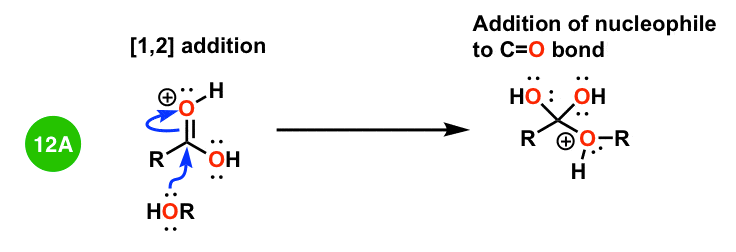
Whereby the nucleophile adds to the carbonyl carbon, forming a new bond and breaking the [PI] bond beween the carbon and oxygen. Note that the neutral nucleophile is positively charged and the (former) carbonyl oxygen is neutral. An acid base reaction can now ensue, a fancy name for which is….
Proton transfer (step 3)

where a proton is transferred from the atom which previously acted as a nucleophile to a different atom on the molecule (either O or N). Once the proton has been transferred, the group becomes much less basic, which also means that it will be a much better leaving group. So one of the lone pairs from an adjacent atom forms a new Pi bond with the carbon, resulting in…
1,2-elimination (step 4),

ejecting a neutral molecule (such as H2O or NH3) as a leaving group. There’s just one more step to go. The atom participating in the new Pi bond has a positive charge, which means we have to remove it in order to get a neutral species – a step we call…
Deprotonation (step 5)

And that’s it. Note that the acid is not consumed – it’s a catalyst here, and can meet up with another molecule of our starting material back in Step 1.
Although the material is spread out over several chapters, the hidden pattern in their mechanism should come in handy when it comes to exam time.
Just remember this: Protonation / 1,2-Addition / Proton transfer / 1,2-Elimination / Deprotonation.
PAPED.
I’ve been trying to come up with a good mnemonic for this. Piranhas Attack People Every Day? Here’s a random mnemonic generator.
PS – Here are the six mechanisms I’m talking about, broken down this way:
00 General Chemistry Review
01 Bonding, Structure, and Resonance
- How Do We Know Methane (CH4) Is Tetrahedral?
- Hybrid Orbitals and Hybridization
- How To Determine Hybridization: A Shortcut
- Orbital Hybridization And Bond Strengths
- Sigma bonds come in six varieties: Pi bonds come in one
- Dipole Moments and Dipoles
- A Key Skill: How to Calculate Formal Charge
- The Four Intermolecular Forces and How They Affect Boiling Points
- 3 Trends That Affect Boiling Points
- How To Use Electronegativity To Determine Electron Density (and why NOT to trust formal charge)
- Introduction to Resonance
- How To Use Curved Arrows To Interchange Resonance Forms
- Evaluating Resonance Forms (1) - The Rule of Least Charges
- How To Find The Best Resonance Structure By Applying Electronegativity
- Evaluating Resonance Structures With Negative Charges
- Evaluating Resonance Structures With Positive Charge
- Exploring Resonance: Pi-Donation
- Exploring Resonance: Pi-acceptors
- In Summary: Evaluating Resonance Structures
- Drawing Resonance Structures: 3 Common Mistakes To Avoid
- How to apply electronegativity and resonance to understand reactivity
- Bond Hybridization Practice
- Structure and Bonding Practice Quizzes
- Resonance Structures Practice
02 Acid Base Reactions
- Introduction to Acid-Base Reactions
- Acid Base Reactions In Organic Chemistry
- The Stronger The Acid, The Weaker The Conjugate Base
- Walkthrough of Acid-Base Reactions (3) - Acidity Trends
- Five Key Factors That Influence Acidity
- Acid-Base Reactions: Introducing Ka and pKa
- How to Use a pKa Table
- The pKa Table Is Your Friend
- A Handy Rule of Thumb for Acid-Base Reactions
- Acid Base Reactions Are Fast
- pKa Values Span 60 Orders Of Magnitude
- How Protonation and Deprotonation Affect Reactivity
- Acid Base Practice Problems
03 Alkanes and Nomenclature
- Meet the (Most Important) Functional Groups
- Condensed Formulas: Deciphering What the Brackets Mean
- Hidden Hydrogens, Hidden Lone Pairs, Hidden Counterions
- Don't Be Futyl, Learn The Butyls
- Primary, Secondary, Tertiary, Quaternary In Organic Chemistry
- Branching, and Its Affect On Melting and Boiling Points
- The Many, Many Ways of Drawing Butane
- Wedge And Dash Convention For Tetrahedral Carbon
- Common Mistakes in Organic Chemistry: Pentavalent Carbon
- Table of Functional Group Priorities for Nomenclature
- Summary Sheet - Alkane Nomenclature
- Organic Chemistry IUPAC Nomenclature Demystified With A Simple Puzzle Piece Approach
- Boiling Point Quizzes
- Organic Chemistry Nomenclature Quizzes
04 Conformations and Cycloalkanes
- Staggered vs Eclipsed Conformations of Ethane
- Conformational Isomers of Propane
- Newman Projection of Butane (and Gauche Conformation)
- Introduction to Cycloalkanes
- Geometric Isomers In Small Rings: Cis And Trans Cycloalkanes
- Calculation of Ring Strain In Cycloalkanes
- Cycloalkanes - Ring Strain In Cyclopropane And Cyclobutane
- Cyclohexane Conformations
- Cyclohexane Chair Conformation: An Aerial Tour
- How To Draw The Cyclohexane Chair Conformation
- The Cyclohexane Chair Flip
- The Cyclohexane Chair Flip - Energy Diagram
- Substituted Cyclohexanes - Axial vs Equatorial
- Ranking The Bulkiness Of Substituents On Cyclohexanes: "A-Values"
- Cyclohexane Chair Conformation Stability: Which One Is Lower Energy?
- Fused Rings - Cis-Decalin and Trans-Decalin
- Naming Bicyclic Compounds - Fused, Bridged, and Spiro
- Bredt's Rule (And Summary of Cycloalkanes)
- Newman Projection Practice
- Cycloalkanes Practice Problems
05 A Primer On Organic Reactions
- The Most Important Question To Ask When Learning a New Reaction
- Curved Arrows (for reactions)
- Nucleophiles and Electrophiles
- The Three Classes of Nucleophiles
- Nucleophilicity vs. Basicity
- What Makes A Good Nucleophile?
- What Makes A Good Leaving Group?
- 3 Factors That Stabilize Carbocations
- Equilibrium and Energy Relationships
- 7 Factors that stabilize negative charge in organic chemistry
- 7 Factors That Stabilize Positive Charge in Organic Chemistry
- What's a Transition State?
- Hammond's Postulate
- Learning Organic Chemistry Reactions: A Checklist (PDF)
06 Free Radical Reactions
- Free Radical Reactions
- 3 Factors That Stabilize Free Radicals
- Bond Strengths And Radical Stability
- Free Radical Initiation: Why Is "Light" Or "Heat" Required?
- Initiation, Propagation, Termination
- Monochlorination Products Of Propane, Pentane, And Other Alkanes
- Selectivity In Free Radical Reactions
- Selectivity in Free Radical Reactions: Bromination vs. Chlorination
- Halogenation At Tiffany's
- Allylic Bromination
- Bonus Topic: Allylic Rearrangements
- In Summary: Free Radicals
- Synthesis (2) - Reactions of Alkanes
- Free Radicals Practice Quizzes
07 Stereochemistry and Chirality
- Types of Isomers: Constitutional Isomers, Stereoisomers, Enantiomers, and Diastereomers
- How To Draw The Enantiomer Of A Chiral Molecule
- How To Draw A Bond Rotation
- Introduction to Assigning (R) and (S): The Cahn-Ingold-Prelog Rules
- Assigning Cahn-Ingold-Prelog (CIP) Priorities (2) - The Method of Dots
- Enantiomers vs Diastereomers vs The Same? Two Methods For Solving Problems
- Assigning R/S To Newman Projections (And Converting Newman To Line Diagrams)
- How To Determine R and S Configurations On A Fischer Projection
- The Meso Trap
- Optical Rotation, Optical Activity, and Specific Rotation
- Optical Purity and Enantiomeric Excess
- What's a Racemic Mixture?
- Chiral Allenes And Chiral Axes
- Stereochemistry Practice Problems and Quizzes
08 Substitution Reactions
- Nucleophilic Substitution Reactions - Introduction
- Two Types of Nucleophilic Substitution Reactions
- The SN2 Mechanism
- Why the SN2 Reaction Is Powerful
- The SN1 Mechanism
- The Conjugate Acid Is A Better Leaving Group
- Comparing the SN1 and SN2 Reactions
- Polar Protic? Polar Aprotic? Nonpolar? All About Solvents
- Steric Hindrance is Like a Fat Goalie
- Common Blind Spot: Intramolecular Reactions
- Substitution Practice - SN1
- Substitution Practice - SN2
09 Elimination Reactions
- Elimination Reactions (1): Introduction And The Key Pattern
- Elimination Reactions (2): The Zaitsev Rule
- Elimination Reactions Are Favored By Heat
- Two Elimination Reaction Patterns
- The E1 Reaction
- The E2 Mechanism
- E1 vs E2: Comparing the E1 and E2 Reactions
- Antiperiplanar Relationships: The E2 Reaction and Cyclohexane Rings
- Bulky Bases in Elimination Reactions
- Comparing the E1 vs SN1 Reactions
- Elimination (E1) Reactions With Rearrangements
- E1cB - Elimination (Unimolecular) Conjugate Base
- Elimination (E1) Practice Problems And Solutions
- Elimination (E2) Practice Problems and Solutions
10 Rearrangements
11 SN1/SN2/E1/E2 Decision
- Identifying Where Substitution and Elimination Reactions Happen
- Deciding SN1/SN2/E1/E2 (1) - The Substrate
- Deciding SN1/SN2/E1/E2 (2) - The Nucleophile/Base
- SN1 vs E1 and SN2 vs E2 : The Temperature
- Deciding SN1/SN2/E1/E2 - The Solvent
- Wrapup: The Key Factors For Determining SN1/SN2/E1/E2
- Alkyl Halide Reaction Map And Summary
- SN1 SN2 E1 E2 Practice Problems
12 Alkene Reactions
- E and Z Notation For Alkenes (+ Cis/Trans)
- Alkene Stability
- Alkene Addition Reactions: "Regioselectivity" and "Stereoselectivity" (Syn/Anti)
- Stereoselective and Stereospecific Reactions
- Hydrohalogenation of Alkenes and Markovnikov's Rule
- Hydration of Alkenes With Aqueous Acid
- Rearrangements in Alkene Addition Reactions
- Halogenation of Alkenes and Halohydrin Formation
- Oxymercuration Demercuration of Alkenes
- Hydroboration Oxidation of Alkenes
- m-CPBA (meta-chloroperoxybenzoic acid)
- OsO4 (Osmium Tetroxide) for Dihydroxylation of Alkenes
- Palladium on Carbon (Pd/C) for Catalytic Hydrogenation of Alkenes
- Cyclopropanation of Alkenes
- A Fourth Alkene Addition Pattern - Free Radical Addition
- Alkene Reactions: Ozonolysis
- Oxidative Cleavage of Vicinal Diols With NaIO4 and Pb(OAc)4
- Summary: Three Key Families Of Alkene Reaction Mechanisms
- Synthesis (4) - Alkene Reaction Map, Including Alkyl Halide Reactions
- Alkene Reactions Practice Problems
13 Alkyne Reactions
- Acetylides from Alkynes, And Substitution Reactions of Acetylides
- Partial Reduction of Alkynes With Lindlar's Catalyst
- Partial Reduction of Alkynes With Na/NH3 To Obtain Trans Alkenes
- Alkyne Hydroboration With "R2BH"
- Hydration and Oxymercuration of Alkynes
- Hydrohalogenation of Alkynes
- Alkyne Halogenation: Bromination and Chlorination of Alkynes
- Oxidation of Alkynes With O3 and KMnO4
- Alkenes To Alkynes Via Halogenation And Elimination Reactions
- Alkynes Are A Blank Canvas
- Synthesis (5) - Reactions of Alkynes
- Alkyne Reactions Practice Problems With Answers
14 Alcohols, Epoxides and Ethers
- Alcohols - Nomenclature and Properties
- Alcohols Can Act As Acids Or Bases (And Why It Matters)
- Alcohols - Acidity and Basicity
- The Williamson Ether Synthesis
- Ethers From Alkenes, Tertiary Alkyl Halides and Alkoxymercuration
- Alcohols To Ethers via Acid Catalysis
- Cleavage Of Ethers With Acid
- Epoxides - The Outlier Of The Ether Family
- Opening of Epoxides With Acid
- Epoxide Ring Opening With Base
- Making Alkyl Halides From Alcohols
- Tosylates And Mesylates
- PBr3 and SOCl2
- Elimination Reactions of Alcohols
- Elimination of Alcohols To Alkenes With POCl3
- Alcohol Oxidation: "Strong" and "Weak" Oxidants
- Demystifying The Mechanisms of Alcohol Oxidations
- Protecting Groups For Alcohols
- Thiols And Thioethers
- Calculating the oxidation state of a carbon
- Oxidation and Reduction in Organic Chemistry
- Oxidation Ladders
- SOCl2 Mechanism For Alcohols To Alkyl Halides: SN2 versus SNi
- Alcohol Reactions Roadmap (PDF)
- Alcohol Reaction Practice Problems
- Epoxide Reaction Quizzes
- Oxidation and Reduction Practice Quizzes
15 Organometallics
- What's An Organometallic?
- Formation of Grignard and Organolithium Reagents
- Organometallics Are Strong Bases
- Reactions of Grignard Reagents
- Protecting Groups In Grignard Reactions
- Synthesis Problems Involving Grignard Reagents
- Grignard Reactions And Synthesis (2)
- Organocuprates (Gilman Reagents): How They're Made
- Gilman Reagents (Organocuprates): What They're Used For
- The Heck, Suzuki, and Olefin Metathesis Reactions (And Why They Don't Belong In Most Introductory Organic Chemistry Courses)
- Reaction Map: Reactions of Organometallics
- Grignard Practice Problems
16 Spectroscopy
- Degrees of Unsaturation (or IHD, Index of Hydrogen Deficiency)
- Conjugation And Color (+ How Bleach Works)
- Introduction To UV-Vis Spectroscopy
- UV-Vis Spectroscopy: Absorbance of Carbonyls
- UV-Vis Spectroscopy: Practice Questions
- Bond Vibrations, Infrared Spectroscopy, and the "Ball and Spring" Model
- Infrared (IR) Spectroscopy: A Quick Primer On Interpreting Spectra
- IR Spectroscopy: 4 Practice Problems
- 1H NMR: How Many Signals?
- Homotopic, Enantiotopic, Diastereotopic
- Diastereotopic Protons in 1H NMR Spectroscopy: Examples
- 13-C NMR - How Many Signals
- Liquid Gold: Pheromones In Doe Urine
- Natural Product Isolation (1) - Extraction
- Natural Product Isolation (2) - Purification Techniques, An Overview
- Structure Determination Case Study: Deer Tarsal Gland Pheromone
17 Dienes and MO Theory
- What To Expect In Organic Chemistry 2
- Are these molecules conjugated?
- Conjugation And Resonance In Organic Chemistry
- Bonding And Antibonding Pi Orbitals
- Molecular Orbitals of The Allyl Cation, Allyl Radical, and Allyl Anion
- Pi Molecular Orbitals of Butadiene
- Reactions of Dienes: 1,2 and 1,4 Addition
- Thermodynamic and Kinetic Products
- More On 1,2 and 1,4 Additions To Dienes
- s-cis and s-trans
- The Diels-Alder Reaction
- Cyclic Dienes and Dienophiles in the Diels-Alder Reaction
- Stereochemistry of the Diels-Alder Reaction
- Exo vs Endo Products In The Diels Alder: How To Tell Them Apart
- HOMO and LUMO In the Diels Alder Reaction
- Why Are Endo vs Exo Products Favored in the Diels-Alder Reaction?
- Diels-Alder Reaction: Kinetic and Thermodynamic Control
- The Retro Diels-Alder Reaction
- The Intramolecular Diels Alder Reaction
- Regiochemistry In The Diels-Alder Reaction
- The Cope and Claisen Rearrangements
- Electrocyclic Reactions
- Electrocyclic Ring Opening And Closure (2) - Six (or Eight) Pi Electrons
- Diels Alder Practice Problems
- Molecular Orbital Theory Practice
18 Aromaticity
- Introduction To Aromaticity
- Rules For Aromaticity
- Huckel's Rule: What Does 4n+2 Mean?
- Aromatic, Non-Aromatic, or Antiaromatic? Some Practice Problems
- Antiaromatic Compounds and Antiaromaticity
- The Pi Molecular Orbitals of Benzene
- The Pi Molecular Orbitals of Cyclobutadiene
- Frost Circles
- Aromaticity Practice Quizzes
19 Reactions of Aromatic Molecules
- Electrophilic Aromatic Substitution: Introduction
- Activating and Deactivating Groups In Electrophilic Aromatic Substitution
- Electrophilic Aromatic Substitution - The Mechanism
- Ortho-, Para- and Meta- Directors in Electrophilic Aromatic Substitution
- Understanding Ortho, Para, and Meta Directors
- Why are halogens ortho- para- directors?
- Disubstituted Benzenes: The Strongest Electron-Donor "Wins"
- Electrophilic Aromatic Substitutions (1) - Halogenation of Benzene
- Electrophilic Aromatic Substitutions (2) - Nitration and Sulfonation
- EAS Reactions (3) - Friedel-Crafts Acylation and Friedel-Crafts Alkylation
- Intramolecular Friedel-Crafts Reactions
- Nucleophilic Aromatic Substitution (NAS)
- Nucleophilic Aromatic Substitution (2) - The Benzyne Mechanism
- Reactions on the "Benzylic" Carbon: Bromination And Oxidation
- The Wolff-Kishner, Clemmensen, And Other Carbonyl Reductions
- More Reactions on the Aromatic Sidechain: Reduction of Nitro Groups and the Baeyer Villiger
- Aromatic Synthesis (1) - "Order Of Operations"
- Synthesis of Benzene Derivatives (2) - Polarity Reversal
- Aromatic Synthesis (3) - Sulfonyl Blocking Groups
- Birch Reduction
- Synthesis (7): Reaction Map of Benzene and Related Aromatic Compounds
- Aromatic Reactions and Synthesis Practice
- Electrophilic Aromatic Substitution Practice Problems
20 Aldehydes and Ketones
- What's The Alpha Carbon In Carbonyl Compounds?
- Nucleophilic Addition To Carbonyls
- Aldehydes and Ketones: 14 Reactions With The Same Mechanism
- Sodium Borohydride (NaBH4) Reduction of Aldehydes and Ketones
- Grignard Reagents For Addition To Aldehydes and Ketones
- Wittig Reaction
- Hydrates, Hemiacetals, and Acetals
- Imines - Properties, Formation, Reactions, and Mechanisms
- All About Enamines
- Breaking Down Carbonyl Reaction Mechanisms: Reactions of Anionic Nucleophiles (Part 2)
- Aldehydes Ketones Reaction Practice
21 Carboxylic Acid Derivatives
- Nucleophilic Acyl Substitution (With Negatively Charged Nucleophiles)
- Addition-Elimination Mechanisms With Neutral Nucleophiles (Including Acid Catalysis)
- Basic Hydrolysis of Esters - Saponification
- Transesterification
- Proton Transfer
- Fischer Esterification - Carboxylic Acid to Ester Under Acidic Conditions
- Lithium Aluminum Hydride (LiAlH4) For Reduction of Carboxylic Acid Derivatives
- LiAlH[Ot-Bu]3 For The Reduction of Acid Halides To Aldehydes
- Di-isobutyl Aluminum Hydride (DIBAL) For The Partial Reduction of Esters and Nitriles
- Amide Hydrolysis
- Thionyl Chloride (SOCl2) And Conversion of Carboxylic Acids to Acid Halides
- Diazomethane (CH2N2)
- Carbonyl Chemistry: Learn Six Mechanisms For the Price Of One
- Making Music With Mechanisms (PADPED)
- Carboxylic Acid Derivatives Practice Questions
22 Enols and Enolates
- Keto-Enol Tautomerism
- Enolates - Formation, Stability, and Simple Reactions
- Kinetic Versus Thermodynamic Enolates
- Aldol Addition and Condensation Reactions
- Reactions of Enols - Acid-Catalyzed Aldol, Halogenation, and Mannich Reactions
- Claisen Condensation and Dieckmann Condensation
- Decarboxylation
- The Malonic Ester and Acetoacetic Ester Synthesis
- The Michael Addition Reaction and Conjugate Addition
- The Robinson Annulation
- Haloform Reaction
- The Hell–Volhard–Zelinsky Reaction
- Enols and Enolates Practice Quizzes
23 Amines
- The Amide Functional Group: Properties, Synthesis, and Nomenclature
- Basicity of Amines And pKaH
- 5 Key Basicity Trends of Amines
- The Mesomeric Effect And Aromatic Amines
- Nucleophilicity of Amines
- Alkylation of Amines (Sucks!)
- Reductive Amination
- The Gabriel Synthesis
- Some Reactions of Azides
- The Hofmann Elimination
- The Hofmann and Curtius Rearrangements
- The Cope Elimination
- Protecting Groups for Amines - Carbamates
- The Strecker Synthesis of Amino Acids
- Introduction to Peptide Synthesis
- Reactions of Diazonium Salts: Sandmeyer and Related Reactions
- Amine Practice Questions
24 Carbohydrates
- D and L Notation For Sugars
- Pyranoses and Furanoses: Ring-Chain Tautomerism In Sugars
- What is Mutarotation?
- Reducing Sugars
- The Big Damn Post Of Carbohydrate-Related Chemistry Definitions
- The Haworth Projection
- Converting a Fischer Projection To A Haworth (And Vice Versa)
- Reactions of Sugars: Glycosylation and Protection
- The Ruff Degradation and Kiliani-Fischer Synthesis
- Isoelectric Points of Amino Acids (and How To Calculate Them)
- Carbohydrates Practice
- Amino Acid Quizzes
25 Fun and Miscellaneous
- A Gallery of Some Interesting Molecules From Nature
- Screw Organic Chemistry, I'm Just Going To Write About Cats
- On Cats, Part 1: Conformations and Configurations
- On Cats, Part 2: Cat Line Diagrams
- On Cats, Part 4: Enantiocats
- On Cats, Part 6: Stereocenters
- Organic Chemistry Is Shit
- The Organic Chemistry Behind "The Pill"
- Maybe they should call them, "Formal Wins" ?
- Why Do Organic Chemists Use Kilocalories?
- The Principle of Least Effort
- Organic Chemistry GIFS - Resonance Forms
- Reproducibility In Organic Chemistry
- What Holds The Nucleus Together?
- How Reactions Are Like Music
- Organic Chemistry and the New MCAT
26 Organic Chemistry Tips and Tricks
- Common Mistakes: Formal Charges Can Mislead
- Partial Charges Give Clues About Electron Flow
- Draw The Ugly Version First
- Organic Chemistry Study Tips: Learn the Trends
- The 8 Types of Arrows In Organic Chemistry, Explained
- Top 10 Skills To Master Before An Organic Chemistry 2 Final
- Common Mistakes with Carbonyls: Carboxylic Acids... Are Acids!
- Planning Organic Synthesis With "Reaction Maps"
- Alkene Addition Pattern #1: The "Carbocation Pathway"
- Alkene Addition Pattern #2: The "Three-Membered Ring" Pathway
- Alkene Addition Pattern #3: The "Concerted" Pathway
- Number Your Carbons!
- The 4 Major Classes of Reactions in Org 1
- How (and why) electrons flow
- Grossman's Rule
- Three Exam Tips
- A 3-Step Method For Thinking Through Synthesis Problems
- Putting It Together
- Putting Diels-Alder Products in Perspective
- The Ups and Downs of Cyclohexanes
- The Most Annoying Exceptions in Org 1 (Part 1)
- The Most Annoying Exceptions in Org 1 (Part 2)
- The Marriage May Be Bad, But the Divorce Still Costs Money
- 9 Nomenclature Conventions To Know
- Nucleophile attacks Electrophile
27 Case Studies of Successful O-Chem Students
- Success Stories: How Corina Got The The "Hard" Professor - And Got An A+ Anyway
- How Helena Aced Organic Chemistry
- From a "Drop" To B+ in Org 2 – How A Hard Working Student Turned It Around
- How Serge Aced Organic Chemistry
- Success Stories: How Zach Aced Organic Chemistry 1
- Success Stories: How Kari Went From C– to B+
- How Esther Bounced Back From a "C" To Get A's In Organic Chemistry 1 And 2
- How Tyrell Got The Highest Grade In Her Organic Chemistry Course
- This Is Why Students Use Flashcards
- Success Stories: How Stu Aced Organic Chemistry
- How John Pulled Up His Organic Chemistry Exam Grades
- Success Stories: How Nathan Aced Organic Chemistry (Without It Taking Over His Life)
- How Chris Aced Org 1 and Org 2
- Interview: How Jay Got an A+ In Organic Chemistry
- How to Do Well in Organic Chemistry: One Student's Advice
- "America's Top TA" Shares His Secrets For Teaching O-Chem
- "Organic Chemistry Is Like..." - A Few Metaphors
- How To Do Well In Organic Chemistry: Advice From A Tutor
- Guest post: "I went from being afraid of tests to actually looking forward to them".
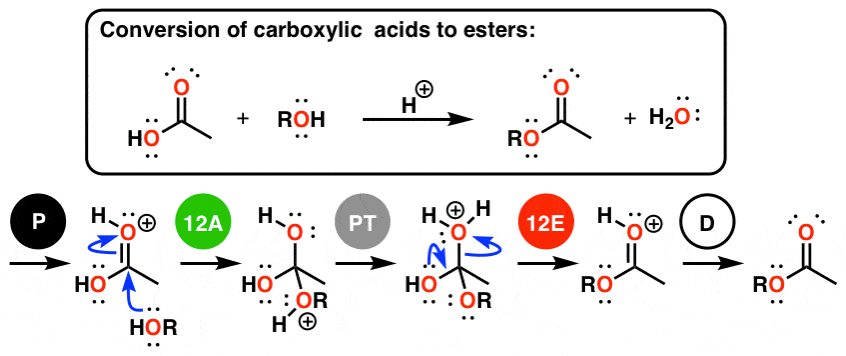
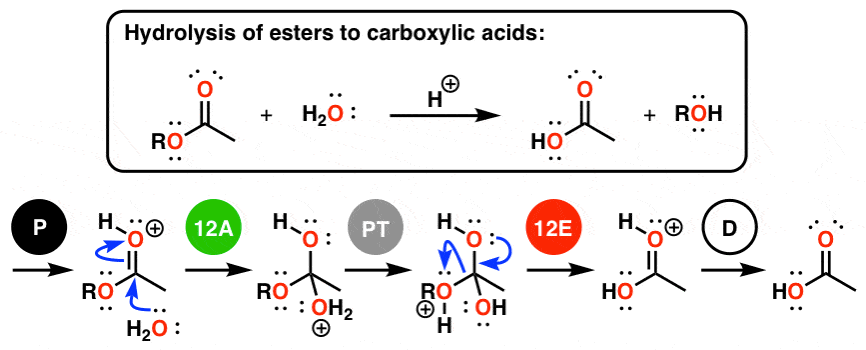
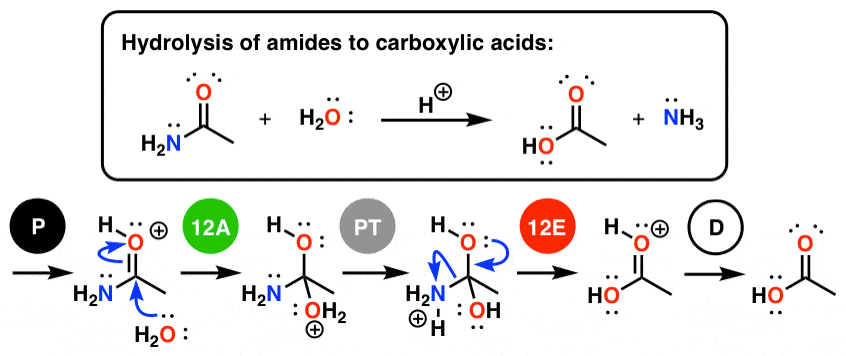
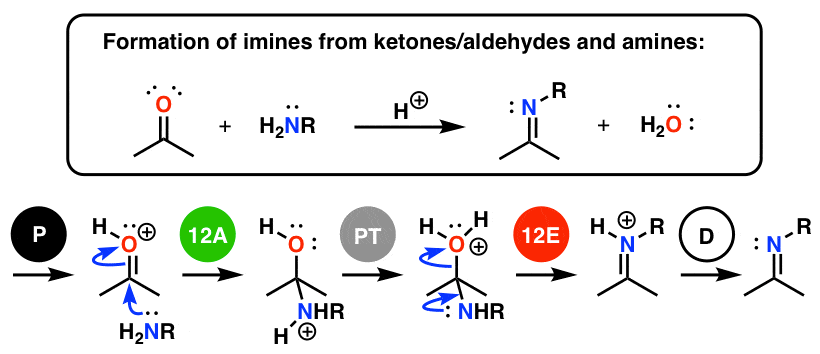
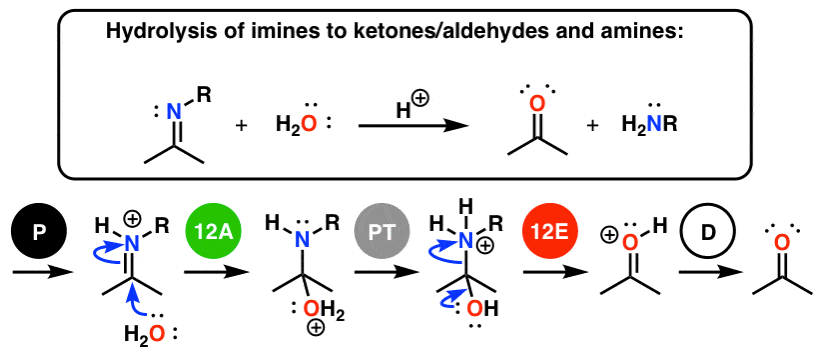
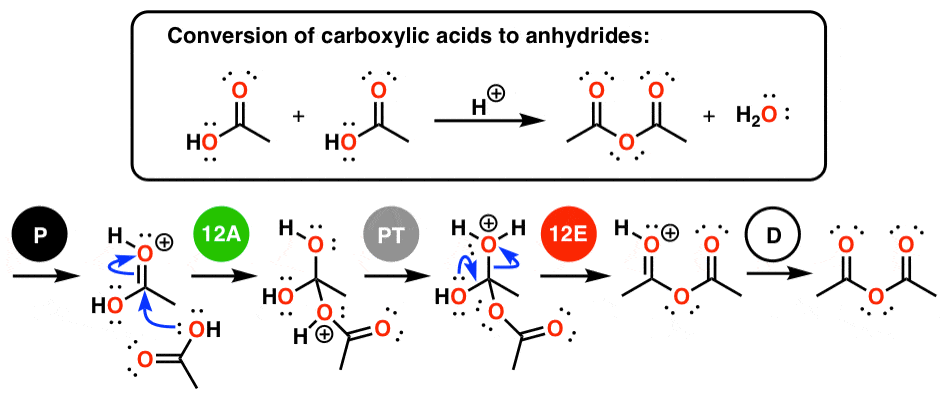
i need a pdf with all carboylic acid derivaitves
and list of all organic derivatives
Hello, I’d like to know how could we tell which functional group in a molecule is more reactive than the other, in other words : on which functional group the reaction will take place ( like in the case of addition or protonation). I also have the same question but this time for atoms in the same functional group like for example which oxygen in an ester is more basic and thus would undergo protonation by an acid or in the case of the last reaction in this post ”Conversion of carboxylic acids to anhydrides” why was it the oxygen with the H that did the 1,2 addition and not the oxygen with the double bond ? it’s the same atom (O) and it has the same number of lone electron pairs (2). do you have a post or several posts that covers all of these questions ? If yes could you please provide the link(s) to them ?
The RDX step of acyl substitution-elimination reactions like all those above is the formation of tetrahedral intermidiate,so rate of reactions should almost depend on the energy of Transition state of this step and this Transition state only consists of formation of transition bond of nucleophile with carbonyl carbon and breaking of carbonyl oxygen pi bond.There is no role of the bond of the leaving group(LEAVING GROUP:the group which leaves at last) .Then why rate of acyl substitution depend on the tendency of leaving group to leave(eg. acyl chloride are most reactive and amides are least reactive).
Great post as always!
In Klein’s text, he explains that protonation of the carbonyl O is not likely in the production of imines or enamines. So that threw me a bit off.
Secondly, in your mechanism for anhydride 1,2-addition, the arrow doesn’t make sense. (At least from my perspective)
Thanks!
If it helps anybody, the mnemonic PAPER works for this mechanism; it’s not super specific, but IMO mnemonics are meant to help rejog your memory:
Protonate Carbonyl
Addition of Nucleophile
Proton Transfer
Eliminate H2O
Restore Carbonyl via Deprotonation
Omg I can’t even express in words how useful this website is for my exam preparation.
THANK YOU. Really appreciate it:D
Hi James,
I love this! Isn’t the anagram a bit misleading for the formation of imines? I get that you need to protonate the O at some point but surely as a 1st step it would inhibit the approach of the RNH2 (which would also presumably protonate before C=O)
Thanks, Tom
Hi,
I have a huge orgo 2 exam in two weeks. I’m a little confused about the mechanisms. I’m always confused on what will be protonated/ deprotonated in the different mechanisms. I’m still waiting for that lightbulb to go off haha. My professor wants us to memorize the mechanisms, but I’d like to know exactly why all the steps in each mechanism happen the way they do. I really want to understand this better. Help =(
In the conversion of carboxylic acid to anhydride mechanism, the second structure isn’t right, the proton is on the wrong oxygen.
Shoot. You are correct. Thanks for the spot.
I’d go a bit perverted if it were one of my organic chemisty students, but I like the idea of an acronym. I try to use words that sound like what’s actually happening. So, for example, instead of PAPED I would use PATED (or RAPED) and make it the Penis (Proton) Added himself, Transferred himself, got shit on (Eliminated), and De-Penified (got cut off). So P for Penis (and Proton), Added, Transferred, got shit on (Eliminated), and cut off (Bobbit style). Would likely work well for guys but equally good for girls, so I have found.
On the proton transfer (step 3) why shouldnt it say electrophilic?
“where a proton is transferred from the *nucleophilic* atom to a different atom (either O or N)”
If you read it again it says “which previously acted as a nucleophile”.
Electrophilic substances are either positively charged or have vacant orbitals which attract electrons(or they are attracted to electrons?).In this case proton transfer from oxygen doesn’t make it an electrophile.
This is why James’s is awesome. This helped me alot on my orgo 2 midterm.
James,
The fischer esterification mechanism (acetic acid with ethanol, sulfuric acid, and heat) in my text book is described as the following:
1. Protonation of carbonyl oxygen from ethyloxonium ion
2. nuclephilic addition of ethanol
3. deprotonation of oxonium ion to form neutral tetrahedral intermediate
4. protonation of hydroxyl oxygen
5. 1,2 elimination
6. deprotonation.
Why may step three and four be as shown above rather than your described mechanism with an intramolecular proton transfer?
Thanks Josh
I cheat here and draw “proton transfer” as one step. It’s possible to draw it in several different ways. The explanation in your textbook is probably more correct, but the net result is the same. I drew the alternative mechanism here (at bottom) – https://masterorganicchemistry.com/reaction-guide/conversion-of-carboxylic-acids-to-esters-using-acid-and-alcohols-fischer-esterification/
I have one question with this reaction though James. It seems imperative that only one of the carbonyl groups is protonated. I understand, I think, that the carbonyl is more basic compared to the OH group on the carboxylic acid, but it seems to me, having both molecules(carbonyl functional groups) protonated, would be a problem. So Ive tried to figure out how a chemist would optimize only one of the acids being protonated, and can only come up with a speedy addition of the acid catalyst, to an already under mild reflux conditions. It just seems to make sense, the quicker this reaction can happen, the better. The longer the acid catalyst remains with the molecule in question, the longer it has to protonate both of the carbonyls. Also the acid catalyst and the amount used must play a part in this. Theoretically, we only want half the molar amount of the carboxylic used, but considering how it is being regenerated, perhaps even a much smaller amount would be better, would reduce the amount of carbonyls being protonated, hence that is probably how a chemist would go about this. USE the minimal amount of catalyst. I also thought of what catalyst would be best used. I thought of H2SO4, but need to look at the pKa of this diprotic acid, as the goal is to remove the H2O formed, and not turn it back into an acid, that will play a further role. Anyway, just thinking this though. Thankyou. I have my butanoic to play with, and pretty sure I can work on this.
what I meant was that water remained in the DS trap, and the mix started to drip back into the pot, like you said. Water forming, to me at least proves the mech, so I think this is what has happened.
Yes, for water to of formed, the mechanisms must of worked. The DS reasonably quickly started to fill with two layers. So I’d take it the anhydride would be within the mix of the toluene, carboxylic acid used, and as stated the water is now removed. So the next step is using a good long column, (vigreux – maybe) to separate. Am I making sense, or got things backwards.
Thanks for the response James. So if i am getting this right, the co – solvent and toluene is somewhat bonding well, thus allowing the water to be separated via a DS trap. What I do not understand, and feel I need to, is how can carboxylates bond well with say methyl benzene. I could sort of understand this with butanoic acid,(4 carbons and their H’s, but for acetic acid, which has a methyl group and a carboxylic acid which would H bond with itself, and with water. I am confused. Obviously. Ill look up the use of co solvents(DS traps) with respect to driving of water, and see where I land. This is good, as I am learning via such a problem. etc. Sorry if this is annoying. !!
Well, water and toluene (as well as water and benzene) form an azeotrope, and boil off together. The distillate ends up in the Dean Stark trap, and the water, being more dense than toluene, settles at the bottom and doesn’t come out. Excess toluene fills the trap, and trickles back down into the reaction flask.
oops, reflux conditions (not concoctions)
I always assumed that the making of anhydrides was a little more trickier than what has been presented here. I assumed that for an eg, acetyl Chlorides were required due to the chloride being a better leaving group. – but hey, Im an undergrad and here to learn. But still surprised to see that latter reaction.
Well, there are two big ways. The first is the way you mentioned – adding carboxylates to acid halides, and this forms anhydrides. The second is by heating carboxylic acids with acid, which leads to loss of water (hence, “anhydrides”)
I’d love to experiment with this. I dare say separating water from the formed anhydride from the mix would be necessary. The densities are pretty close, and under reflux concoctions DS would be out, so perhaps just a HCl catalyst, with acetic acid under reflux with a (DRY) CaCl2 drying tube fitted at the end. I wish my chem Professors would allow me to explore this, say with butanoic acid – as stinky as it is, but bypasses the issue of anhydrides and their legalities with respect to acetic and propanoic. Anyway, thankyou for your response.
It’s not a very broadly useful method since it can only make symmetrical anhydrides, but this almost certainly how commercial acetic anhydride is made.
Re: butanoic acid, why rule out Dean-Stark? Use benzene or toluene as co-solvent, the water will be driven off, allowing the reaction to go to completion. Although you will probably want to avoid social contact afterwards…..
SIR MY CHEMISTRY IS VERY WEAK
. I’M 2nd year student plzzzzzzzzzzz help me
LOL good luck
Hi James,
In McMurry’s ‘Organic Chemistry’, they give the imine mechanism (and similar ones) like this:
1. Nucleophilic attack on the carbonyl carbon
2. Proton transfer from the nitrogen to the carbonyl oxygen
3. Protonation of the hydroxyl to form a good leaving group
4. Elimination of water
5. Deprotonation
—-
I’ve read both ways: yours appears in ‘Instant Notes’ and elsewhere.
So which is correct? Or does it not matter? I’m just wondering, in my exam, if I give one or the other, will it matter?
Cheers
Peter
Good question – it depends on pH. At neutral pH it operates similarly to what you mentioned. It’s also slower. As you go to lower pH, you’ll start to protonate the carbonyl oxygen (through the mechanism mentioned in this post) which results in a faster reaction.